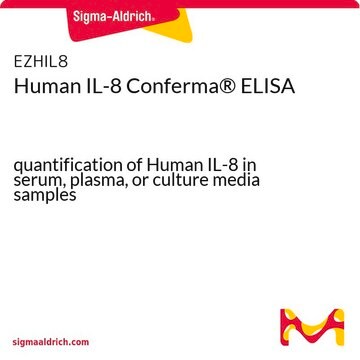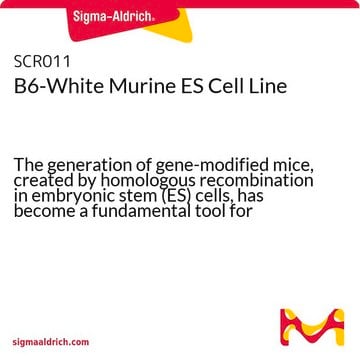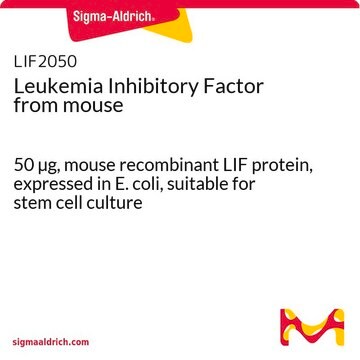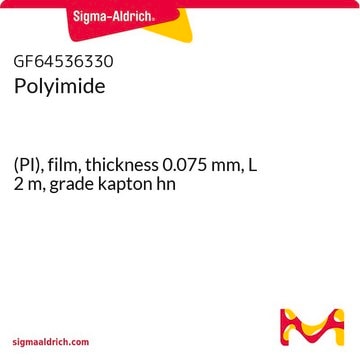07072001
ES-R1 from mouse
07072001, mouse embryo. Monolayer of spheroidal cells on feeder layer of PMEFs.
Sign Into View Organizational & Contract Pricing
All Photos(1)
About This Item
UNSPSC Code:
41106514
NACRES:
NA.81
Recommended Products
product name
ES-R1 from mouse,
biological source
mouse embryo
form
liquid
growth mode
Adherent
karyotype
Not specified
morphology
Adherent monolayer of spheroidal cells on feeder layer of mouse primary embryonic fibroblasts
products
Not specified
receptors
Not specified
technique(s)
cell culture | mammalian: suitable
shipped in
dry ice
storage temp.
−196°C
Cell Line Origin
Mouse embryonic stem cell
Cell Line Description
Pluripotent mouse embryonic stem cell line. R1 ES cells were established in August 1991 from a male blastocyst hybrid of two 129 substrains (129X1/SvJ and 129S1/SV-+p+Tyr-c Kitl Sl-J/+).
Culture Medium
MEF medium consists of Advanced DMEM/F12 (Invitrogen 12634010), 10% FBS (Perbio SH30070.03E), 2 mM Glutamine (Invitrogen 25030024) and 0.1 mM ß-mercaptoethanol (Sigma M6250).
KSR medium consists of KO-DMEM (Gibco 10829), 20% Knock-Out Serum Replacer (Gibco 10828), 2 mM Glutamine (Invitrogen 25030024), NEAA (Invitrogen 11140035), 0.1 mM ß-mercaptoethanol (Sigma M6250) and LIF 1000 Units/ml (ESGRO ESG1106).
KSR medium consists of KO-DMEM (Gibco 10829), 20% Knock-Out Serum Replacer (Gibco 10828), 2 mM Glutamine (Invitrogen 25030024), NEAA (Invitrogen 11140035), 0.1 mM ß-mercaptoethanol (Sigma M6250) and LIF 1000 Units/ml (ESGRO ESG1106).
Subculture Routine
Embryonic stem (ES) cells require the use of mitotically inactivated feeder cells to support the growth of stem cells in the undifferentiated state. Mouse embryonic fibroblasts, STO (Sigma catalog no. 86032003) or SNL 76/7 (Sigma catalog no. 07032801) can be used. At ECACC plastic ware is pre-coated with gelatine prior to plating feeder cells.
Porcine gelatine (Sigma G1890) is dissolved in sterile water (0.5 g/500 ml) at 56 °C. The 0.1% solution is sterilized by filtration (0.22 μm). Add 0.1% gelatine to plastic ware to cover bottom, and incubate for 20 minutes at room temperature. Remove gelatine, wash with PBS once and replace with appropriate culture medium. The flask/dish must not be allowed to dry out.
Feeder layers are prepared on the gelatinized flasks at least 24 hours in advance of being required. An ampoule is thawed in 37 °C water bath and the contents quickly transferred to a 15 ml centrifuge tube. MEF medium is added drop wise to 5 ml. Cells are centrifuged at 150 x g for 5 minutes at room temperature (RT). Cells are resuspended in 5 ml of MEF medium. Cells are counted and added to flasks containing the correct medium at 1-3 x 104 cells/cm2.
An ampoule of ES cells is thawed in 37 °C water bath and the contents quickly transferred to a 15 ml centrifuge tube. KSR medium is added drop wise to 5 ml. Cells are centrifuged at 150 x g for 5 minutes. Cells are resuspended in 5 ml of KSR medium. The prepared feeder flask is washed once with PBS and KSR medium added. ES cells should be plated at 4-5 x 104 cells/cm2. Cultures must be incubated in a humidified 5% CO2/95% air incubator at 37 °C. A 100% media change must be performed every day and cells passaged every 2-3 days. Colonies must not be allowed to touch each other as overgrowth will result in differentiation.
Porcine gelatine (Sigma G1890) is dissolved in sterile water (0.5 g/500 ml) at 56 °C. The 0.1% solution is sterilized by filtration (0.22 μm). Add 0.1% gelatine to plastic ware to cover bottom, and incubate for 20 minutes at room temperature. Remove gelatine, wash with PBS once and replace with appropriate culture medium. The flask/dish must not be allowed to dry out.
Feeder layers are prepared on the gelatinized flasks at least 24 hours in advance of being required. An ampoule is thawed in 37 °C water bath and the contents quickly transferred to a 15 ml centrifuge tube. MEF medium is added drop wise to 5 ml. Cells are centrifuged at 150 x g for 5 minutes at room temperature (RT). Cells are resuspended in 5 ml of MEF medium. Cells are counted and added to flasks containing the correct medium at 1-3 x 104 cells/cm2.
An ampoule of ES cells is thawed in 37 °C water bath and the contents quickly transferred to a 15 ml centrifuge tube. KSR medium is added drop wise to 5 ml. Cells are centrifuged at 150 x g for 5 minutes. Cells are resuspended in 5 ml of KSR medium. The prepared feeder flask is washed once with PBS and KSR medium added. ES cells should be plated at 4-5 x 104 cells/cm2. Cultures must be incubated in a humidified 5% CO2/95% air incubator at 37 °C. A 100% media change must be performed every day and cells passaged every 2-3 days. Colonies must not be allowed to touch each other as overgrowth will result in differentiation.
Other Notes
Additional freight & handling charges may be applicable for Asia-Pacific shipments. Please check with your local Customer Service representative for more information.
Cultures from HPA Culture Collections and supplied by Sigma are for research purposes only. Enquiries regarding the commercial use of a cell line are referred to the depositor of the cell line. Some cell lines have additional special release conditions such as the requirement for a material transfer agreement to be completed by the potential recipient prior to the supply of the cell line. Please view the Terms & Conditions of Supply for more information.
Depositor and originator: Dr A Nagy, Samuel Lunenfeld Research Institute, Mount Sinai Hospital, 600 University Ave, Toronto, Ontario, M5G 1X5, Canada.
Storage Class Code
10 - Combustible liquids
WGK
WGK 3
Flash Point(F)
Not applicable
Flash Point(C)
Not applicable
Certificates of Analysis (COA)
Search for Certificates of Analysis (COA) by entering the products Lot/Batch Number. Lot and Batch Numbers can be found on a product’s label following the words ‘Lot’ or ‘Batch’.
Already Own This Product?
Find documentation for the products that you have recently purchased in the Document Library.
Anne Plück et al.
Methods in molecular biology (Clifton, N.J.), 561, 199-217 (2009-06-09)
Since the technique of introducing a targeted mutation ('gene targeting') into the mouse genome was published almost 20 years ago (Cell 51:503-512, 1987), the number of mouse mutants (mouse models) is increasing, especially after the advent of the full mouse
A Nagy et al.
Proceedings of the National Academy of Sciences of the United States of America, 90(18), 8424-8428 (1993-09-15)
Several newly generated mouse embryonic stem (ES) cell lines were tested for their ability to produce completely ES cell-derived mice at early passage numbers by ES cell <==> tetraploid embryo aggregation. One line, designated R1, produced live offspring which were
Our team of scientists has experience in all areas of research including Life Science, Material Science, Chemical Synthesis, Chromatography, Analytical and many others.
Contact Technical Service








